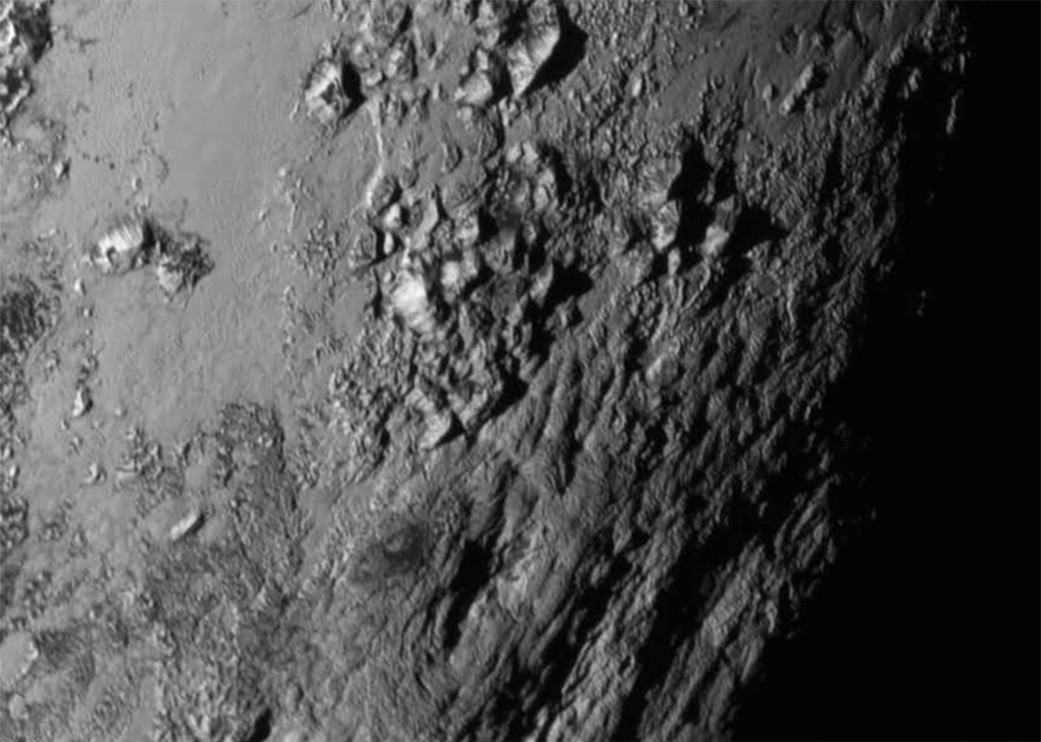Well, Hello, Pluto!
Our most up-close-and-personal shot of the (dwarf) planet yet.

This is Pluto—or, more specifically, a close-up of terrain bordering a heart-shaped feature dubbed “Tombaugh Regio,” for Pluto’s discoverer, Clyde Tombaugh. The detail reveals a range of “young” mountains rising as high as 11,000 feet, which probably formed no more than 100 million years ago and might still be geologically active.
NASA’s New Horizons spacecraft captured the image about an hour and a half before making its closest approach to Pluto—a heralded arrival that occurred when many of us on the East Coast were eating breakfast yesterday.
The flyby had been a long time coming. Scientists launched the New Horizons spacecraft on January 19, 2006 (can you recall what you were doing that day?), and it had been homing in on Pluto, which hangs out in the Kuiper Belt—a sprawling region of ancient, icy, rocky bodies beyond Neptune—ever since.
The probe is about the size of a baby grand piano, and speedy. In fact, it’s the fastest spacecraft ever launched in history, according to Allen Stern, New Horizons principal investigator and a planetary scientist at the Southwest Research Institute. What’s more, “the ocean of space that we crossed from the Earth to Pluto is farther than any spacecraft has ever traveled to its primary target: 3 billion miles from the Earth,” Stern told Ira Flatow during the Science Friday broadcast on July 10th.
The mission marks the capstone of an era—what Stern described as “the anchor leg in a 50-year enterprise to make the first reconnaissance of all the planets.” Indeed, a half-century ago to the day of New Horizon’s flyby was when we first explored Mars (with NASA’s Mariner 4), and through subsequent missions, probes have investigated every planet in the solar system, save for that small sphere with the Underworld-ly name.
“Pluto’s kind of the belle of the ball,” said Stern. “[It] has a lot to teach us about the origin of solar system; has a lot to teach us about small planets orbiting beyond the giant planets; has some things to teach us even about the origin of the Earth.”
Starting Monday evening at 11:17 p.m. E.T., New Horizons slipped out of contact—by design—so that it could collect as much data as possible during its flyby. Finally, last night at 8:52:37 p.m E.T., mission operations at the Johns Hopkins University Applied Physics Laboratory in Maryland received a signal from the craft indicating that the pioneering probe was alive and kicking, which prompted a round of cheers from the team. After a series of system check-ins, New Horizons operations manager Alice Bowman announced, “We have a healthy spacecraft. We’ve recorded data of the Pluto system, and we’re outbound from Pluto.”
The data New Horizons collects will shower down on hungry eyes on Earth for more than a year. “This is true exploration,” said Stern on Friday. “We are flying into the unknown to a place that no one’s ever been before, a class of planet no one’s ever been before, and we are going to write the textbook from scratch.”
Tune in to Science Friday on July 17 for an update on the New Horizons mission. @SciFri has also been keeping tabs on the flyby; here’s a tweet sampler:
Our 3-billion-mile journey to Pluto reaches historic #PlutoFly! Details & the high-res image: http://t.co/qX7KpXIUUQ pic.twitter.com/LDjXLtPdly — NASA (@NASA) July 14, 2015
RELEASED: Enhanced color image shows #Pluto‘s compositional diversity during #PlutoFlyby. http://t.co/8468Jp50Tm pic.twitter.com/sab64kB4p5
— NASA New Horizons (@NASANewHorizons) July 14, 2015
Don’t do something because it’s easy. Do something because you want to. Give yourself that challenge. –Alice Bowman, Mission Ops Mgr — Charles Bergquist (@cbquist) July 15, 2015
Happy members of the @NewHorizons2015 team #PlutoFlyby pic.twitter.com/LCmmr5kDtA
— Julie Leibach (@julieleibach) July 15, 2015
Congrats to the entire @NASANewHorizons team! pic.twitter.com/PsNlbchK6c — Science Friday (@scifri) July 15, 2015
.@NASANewHorizons has been making history in more ways than one. http://t.co/WRstBDVVKQ #PlutoFlyby pic.twitter.com/meU2ViAFji — Science Friday (@scifri) July 15, 2015
.@NASANewHorizons is okay! They are in lock with the spacecraft! #PlutoFlyby pic.twitter.com/NkEsCTv4Ju — Science Friday (@scifri) July 15, 2015
I recall Viking on Mars, Voyager pix for Jupiter, Saturn, and Neptune. This completes my journey, too. https://t.co/UrZe6jaTvw
— Ira Flatow (@iraflatow) July 14, 2015
How we saw Pluto in 1996, and today #PlutoFlyby @NASANewHorizons pic.twitter.com/snLuhMCd0u
— Science Friday (@scifri) July 14, 2015
#PlutoFlyby has been almost a decade in the making. http://t.co/WRstBDVVKQ pic.twitter.com/GGoqXFCcWO — Science Friday (@scifri) July 15, 2015
Pluto may be small, but it’s still pretty big. For comparison, here’s Manhattan in the surface image. #PlutoFlyby pic.twitter.com/HhGfTpyM51
— Science Friday (@scifri) July 15, 2015
Julie Leibach is a freelance science journalist and the former managing editor of online content for Science Friday.